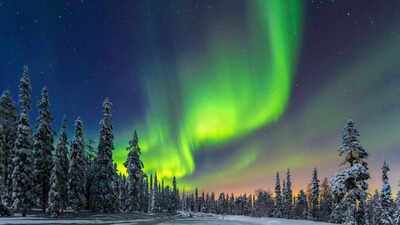ARTICLE AD BOX

Sky watchers across northern parts of the United States may get a rare treat tonight. The northern lights could be visible overnight on August 8–9. This is thanks to a burst of solar energy called a coronal mass ejection (CME) and some fast-moving solar wind heading our way, according to the National Oceanic and Atmospheric Administration (NOAA).While forecasters expect only a glancing hit from the CME, even a small impact can disturb Earth’s magnetic field. That can trigger what’s called a geomagnetic storm, which is what makes auroras appear.
When could the storm arrive?
NOAA and the UK Met Office believe the CME could arrive sometime around 8 a.m. EDT on August 8, but the exact timing is uncertain. The first burst of activity may bring moderate storm conditions, and then things could calm down a bit before picking up again in the evening.
The best chances for bright lights are expected overnight into the early hours of August 9.

The Kp index, which measures geomagnetic activity on a scale of 0 to 9, may reach 5 or 6. Higher numbers mean the aurora can be seen farther south. Tonight’s numbers could be high enough to bring the northern lights into parts of the northern US, if skies are clear and dark enough.
Which states might see the lights?
NOAA’s forecast shows that 18 states are at least partly under the aurora “view line” tonight. These include:Alaska, Montana, North Dakota, Minnesota, Wisconsin, Michigan, Maine, South Dakota, Vermont, New Hampshire, Idaho, Washington, Oregon, New York, Wyoming, Iowa, Nebraska, and Illinois.
The farther north you are in these states, the better your chances. But auroras are unpredictable; sometimes they stretch far beyond forecasts, and other times they barely show at all.
How to improve your chances
If you’re hoping to spot the lights, get away from city glare and find a dark, open spot with a clear view to the north. The best viewing is often late at night, around 2 a.m., but because the storm’s timing is uncertain, it’s worth checking the skies as soon as it gets dark.Some people use aurora alert apps, which send notifications if activity picks up. A few popular ones include “My Aurora Forecast & Alerts” and “Space Weather Live.”The northern lights are more active right now because the sun is near the peak of its 11-year solar cycle. This peak, called the solar maximum, means more solar flares and CMEs, and more chances for colorful skies.



.png)
.png)
.png)
















 3 hours ago
4
3 hours ago
4









 English (US) ·
English (US) ·